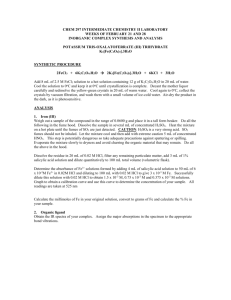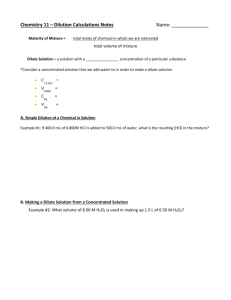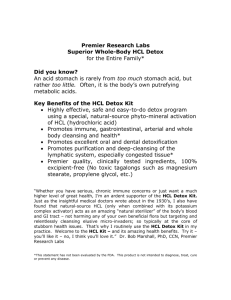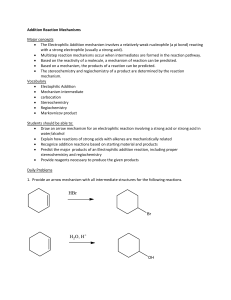Seminuk_report - Princeton University
advertisement
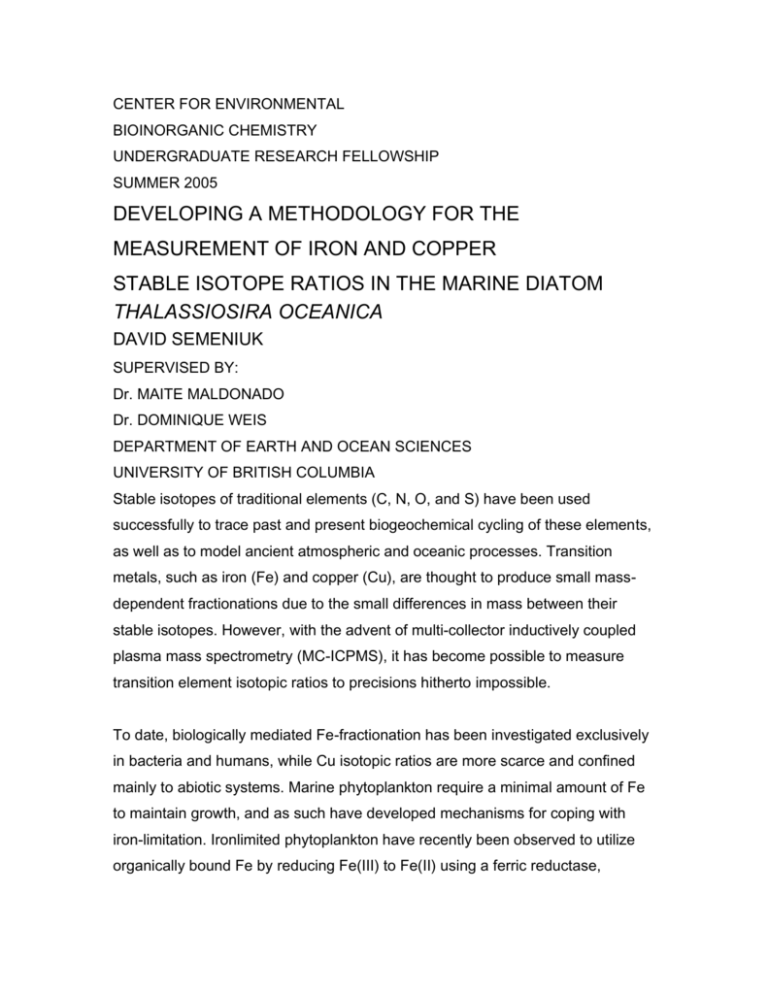
CENTER FOR ENVIRONMENTAL BIOINORGANIC CHEMISTRY UNDERGRADUATE RESEARCH FELLOWSHIP SUMMER 2005 DEVELOPING A METHODOLOGY FOR THE MEASUREMENT OF IRON AND COPPER STABLE ISOTOPE RATIOS IN THE MARINE DIATOM THALASSIOSIRA OCEANICA DAVID SEMENIUK SUPERVISED BY: Dr. MAITE MALDONADO Dr. DOMINIQUE WEIS DEPARTMENT OF EARTH AND OCEAN SCIENCES UNIVERSITY OF BRITISH COLUMBIA Stable isotopes of traditional elements (C, N, O, and S) have been used successfully to trace past and present biogeochemical cycling of these elements, as well as to model ancient atmospheric and oceanic processes. Transition metals, such as iron (Fe) and copper (Cu), are thought to produce small massdependent fractionations due to the small differences in mass between their stable isotopes. However, with the advent of multi-collector inductively coupled plasma mass spectrometry (MC-ICPMS), it has become possible to measure transition element isotopic ratios to precisions hitherto impossible. To date, biologically mediated Fe-fractionation has been investigated exclusively in bacteria and humans, while Cu isotopic ratios are more scarce and confined mainly to abiotic systems. Marine phytoplankton require a minimal amount of Fe to maintain growth, and as such have developed mechanisms for coping with iron-limitation. Ironlimited phytoplankton have recently been observed to utilize organically bound Fe by reducing Fe(III) to Fe(II) using a ferric reductase, followed by oxidation of Fe(II) by a multi-copper containing oxidase, and the subsequent transport of Fe(III) by an Fe permease (Maldonado et al., in press). The transport of Fe was Cu-dependent, and so it is likely that phytoplankton have a considerable effect on the biogeochemical cycling of Fe and Cu isotopes under both iron replete and limited conditions. The goal of my work this summer was to develop a method for adequately digesting the sample material, to isolate Fe and Cu from the sample to reduce possible matrix effects, and finally to perform preliminary isotopic measurements on at least one sample. In order to avoid contaminating samples, and thus altering the original isotopic ratios, rigorous cleaning protocols were developed and followed for all laboratory equipment used. I learned how different plastic materials (i.e. Teflon, HDPE, Polypropylene, etc.) have the potential to contaminate a sample, depending on the elements being analyzed. I also learned how different acids are used to clean for different elements, and that the most effective method is the sequential combination of strong acids and a final leaching step in Milli Q water. These procedures and knowledge will become invaluable during the following year while completing my undergraduate honours thesis. Under Fe-replete conditions, Thalassiosira oceanica, an oceanic diatom, was grown in a fortified recipe of the synthetic ocean water medium Aquil. The cells were filtered, rinsed with chelexed synthetic ocean water, centrifuged, and freeze-dried. The lyophilized sample was transferred to a clean PTFE-digestion vessel, and a mixture 95%/5% (v/v) of concentrated, Ultrapure (Seastar) HNO3/HF was added to the bomb. After the microwave digestion, the sample was dried down to remove residual HF that did not complex as a gas with the siliceous diatom frustules. Once resuspended in a few milliliters of concentrated HNO3, the sample was transferred to a clean PFA digestion vial, and placed on a hot plate. The combination of heat, pressure, and concentrated HNO3 completed the digestion of all remaining organics, as indicated by the evolution of a dark brown gas from the vial. Once the gas production ceased, the sample was heated to near dryness, and resuspended in 7M HCl to prime it for the anion exchange column chemistry. All chemistry was performed in the Class 1000 clean labs of the Pacific Center of Isotope and Geochemical Research (PCIGR) under the guidance of Dr. Jane Barling and Prof. Dominique Weiss. Firstly, to ensure complete separation of Fe and Cu from each other and other elements, a multi-element standard was used to test how effective our -10 0 10 20 30 40 50 60 70 80 90 0 10 20 30 40 50 60 70 80 90 100 Elution Volume (mL) Percent Total Elution Pb Mg Ca Ti V Cr Mn Fe Co Ni Cu Zn Sr LOAD 6M HCl 1M HCl + 0.001% H2O2 protocol was. The sample was loaded onto the prepared column, and eluted with 6M HCl first to remove the Cu, then 1M HCl + 0.001% H2O2 to remove the Fe (Figure 1). Each cut was collected in a clean polypropylene test tube. A second column was used to elute a total Cu and Fe yield into cleaned PFA beakers as would be done during the actual sample analysis. Figure 1: Elution curves for the multi-element standard as the sample load, 6M HCl, and 1M HCl+0.001% H2O2 was added to the column. Element concentrations of each cut were determined using a Thermofinnigan Element2 High resolution ICPMS. Under the technician’s guidance, I learned the importance of matrix effects on the analyte, and methods for reducing them as much as possible. The majority of the major cations were immediately eluted in the first few milliliters, leaving cobalt and zinc (a contaminant) in the Cu cut. The possible matrix effects of Co on the Cu analysis will be carried out once the Co concentrations of the diatoms are determined. Although approximately 100% of the Fe was collected, only 83% Cu yield was achieved. Incomplete elution of Fe and Cu has been shown to induce mass-dependent fractionation, and therefore the chemistry for the diatom sample was to increase the chance of obtaining ≥99% yield. Instead of 6M HCl, 7M HCl + 0.001% H2O2 was used in hopes of stripping off all the Cu from the column before eluting the Fe (Figure 2). 0 10 20 30 40 50 60 70 80 0 10 20 30 40 50 60 70 80 90 100 Elution Volume (mL) Percent Total Elution Cu Fe 7M HCl + 0.001% H202 1M HCl + 0.001% H202 Figure 2: Elution of copper and iron from the digested T. oceanica sample. Again, a significant portion of Cu eluted with the first cut of Fe, and so the Cu isotope analysis has not been performed yet. The total Co was less than 0.1% the total Cu present, and so it likely will not have an effect on the Cu analysis. I plan on determining a method of isolating 100% of the Cu over the course of my honours thesis. Using a Nuplasma MC-ICPMS, Dr. Barling and myself successfully analyzed the stable isotope ratio of Fe for the diatom sample as an exponentially corrected ratio using a Cu dopant (remaining sample Cu likely has no affect, since <0.1% total Fe). The ratio was determined to be approximately 0.3‰ heavier than the in house standard. Unfortunately, a sub-sample of the medium was not taken before inoculating it with the culture, and so an absolute fractionation value for the experiment cannot be determined. I have learned that oceanography is one of the most multidisciplinary faculties in science. It requires a broad understanding of concepts from chemistry, physics, biology, and mathematics. My fellowship this summer has allowed me to broaden my scope to analytical chemistry and geochemistry, and their potential uses for a student of biological oceanography like myself. The work I completed here has peaked my interest in marine biogeochemistry, and consequently myself along with two other students have proposed a student directed seminar here at UBC on the biological pump. I plan on continuing my studies after completing my honours degree by attending graduate school, where the knowledge and skills I have obtained through this fellowship will be used.



